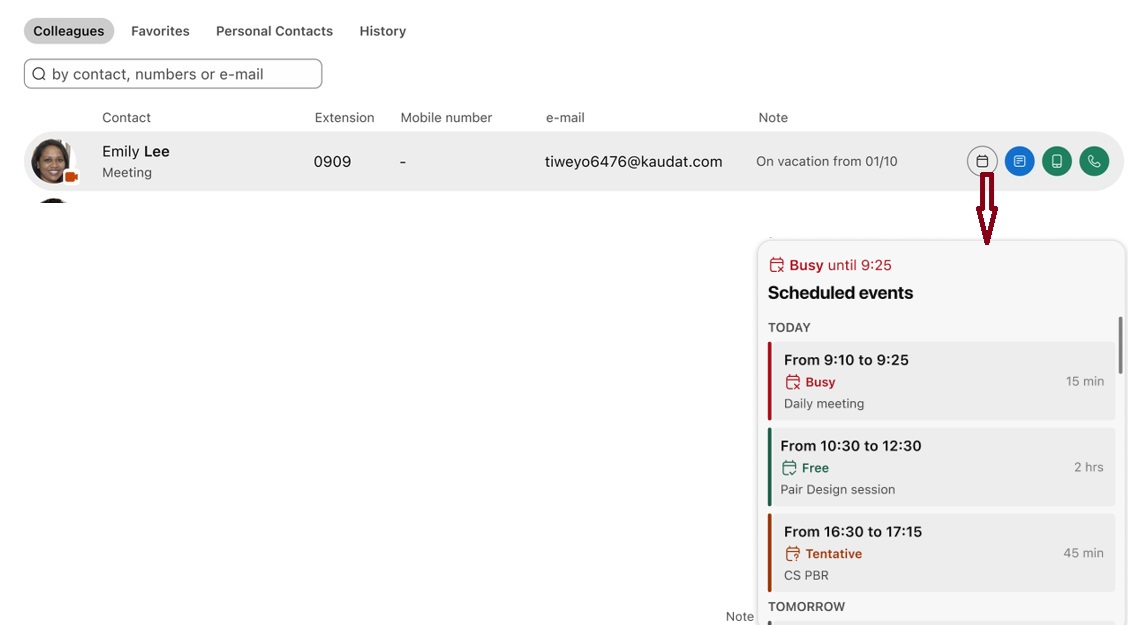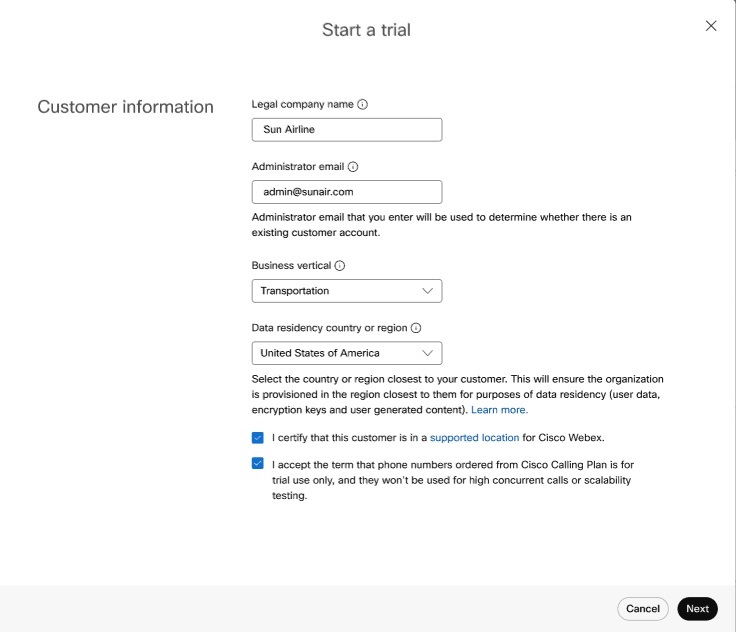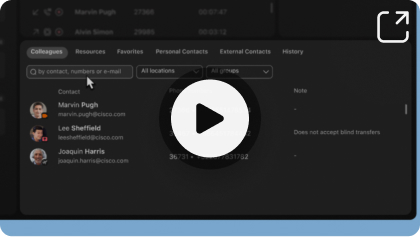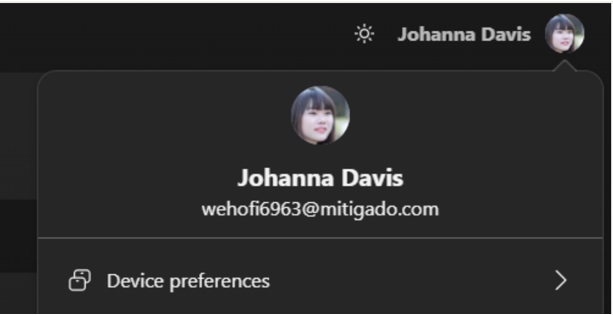- Strona główna
- /
- Artykuł








Rozpocznij korzystanie z konsoli Attendant
 W tym artykule
W tym artykule Opinia?
Opinia?Konsola operatora to narzędzie internetowe łączące usługę Webex Calling, aplikację Webex lub telefon stacjonarny z interfejsem komputera stacjonarnego w celu przetwarzania połączeń w obrębie organizacji lub poza nią. Możesz wyświetlać połączenia przychodzące, zarządzać połączeniami i kontaktami oraz monitorować połączenia w kolejce.
Dostarczanie licencji Attendant Console
Attendant Console to klient nowej generacji, który zaspokaja potrzeby personelu recepcji. Administrator może skonfigurować użytkowników jako konsultantów telefonicznych, aby monitorować wszystkie połączenia przychodzące do określonych osób w organizacji. Zainicjuj obsługę tego klienta za pomocą Control Hub.
Do korzystania z konsoli Attendant wymagana jest licencja. Aby zamówić licencje jako dodatek do zamówienia Webex Calling lub Webex Suite, skorzystaj ze strony internetowej Cisco Commerce (CCW).
Licencję Attendant Console można zamówić w następujący sposób:
-
Z zamówieniem zakupu Flex-3
-
Z nowym zamówieniem subskrypcji Webex Calling
-
Zmiana zamówienia z istniejącą subskrypcją usługi Webex Calling
Wymagania sieciowe dla konsoli Attendant
Konsola Webex Attendant jest zgodna z następującymi systemami operacyjnymi i ich minimalnymi wymaganiami:
| Produkt | Konfiguracja |
|---|---|
|
System operacyjny |
Windows 10 lub nowszy |
|
MacOSX 13 lub nowszy |
|
|
Edytor |
Cztery lub więcej rdzeni fizycznych |
|
Pamięć |
4 GB lub więcej pamięci RAM |
|
Dysk |
Zalecane minimum 5 GB wolnego miejsca na dysku |
Użyj tych informacji, aby skonfigurować korporacyjną zaporę sieciową w taki sposób, aby aplikacje nie były blokowane.
Port TCP: 443 (HTTPS) dla wszystkich połączeń wychodzących.
Domeny i adresy URL dla konsoli Webex AttendantOto domeny najwyższego poziomu i subdomeny, z których korzysta aplikacja:
| Domeny | Opis | Aplikacje korzystające z domen / Adresy URL |
|---|---|---|
|
imagicle.cloud |
Dostęp do sieci komunikacyjnej w chmurze Imagicle |
Aplikacja Webex |
|
imagicle.com |
Dostęp do sieci komunikacyjnej w chmurze Imagicle |
Aplikacja Webex |
|
webexapis.com |
Dostęp do platformy Cisco Webex, z której korzystają mikrousługi Webex w celu zarządzania aplikacjami |
Aplikacja Webex |
|
webexcontent.com |
Przechowywanie w usłudze Webex treści generowanych przez użytkowników i dzienników |
Aplikacja Webex |
|
login.microsoftonline.com |
Integracja z usługą obecności i kalendarzem w zespołach MS Teams |
Aplikacja Webex |
|
graph.microsoft.com |
Integracja z usługą obecności i kalendarzem w zespołach MS Teams |
Aplikacja Webex |
Oto w pełni kwalifikowana nazwa domeny (FQDN) i adresy IP, z którymi aplikacja Webex łączy się w sieci Imagicle Cloud:
| w pełni kwalifikowana nazwa domeny (FQDN) | IP | Obsługiwany region |
|---|---|---|
|
ac.wbx.imagicle.cloud |
(1) |
Wszystkie regiony |
|
eu.api.imagicle.com |
(1) |
Wszystkie regiony |
|
actions-eu.console.imagicle.cloud |
18.196.9.252 |
Europa |
|
events-eu.console.imagicle.cloud |
18.195.152.104 |
Europa |
|
us.api.imagicle.com |
(1) |
Stany Zjednoczone |
|
actions-us.console.imagicle.cloud |
3.216.35.123 107.21.150.121 |
Stany Zjednoczone |
|
events-us.console.imagicle.cloud |
3.216.35.123 107.21.150.121 |
Stany Zjednoczone |
|
au.api.imagicle.com |
(1) |
Australia |
|
actions-au.console.imagicle.cloud |
54.253.32.29 52.64.249.210 |
Australia |
|
events-au.console.imagicle.cloud |
54.253.32.29 52.64.249.210 |
Australia |
|
ca.api.imagicle.com |
(1) |
Kanada |
|
actions-ca.console.imagicle.cloud |
3.96.230.11 15.156.172.181 |
Kanada |
|
events-ca.console.imagicle.cloud |
3.96.230.11 15.156.172.181 |
Kanada |
|
uk.api.imagicle.com |
(1) |
Wielka Brytania |
|
actions-uk.console.imagicle.cloud |
35.178.34.119 3.11.199.94 |
Wielka Brytania |
|
events-uk.console.imagicle.cloud |
35.178.34.119 3.11.199.94 |
Wielka Brytania |
|
jp.api.imagicle.com |
(1) |
Japonia |
|
actions-jp.console.imagicle.cloud |
54.65.182.69 54.168.26.80 |
Japonia |
|
events-jp.console.imagicle.cloud |
54.65.182.69 54.168.26.80 |
Japonia |
(1): Ten punkt końcowy obsługuje wiele adresów IP, a adres może się zmieniać.
Rozpocznij okres próbny konsoli Webex Attendant dla nowych klientów
Rozpocznij okres próbny dla swoich klientów, aby mogli wypróbować usługi konsoli Webex Attendant przed zakupem subskrypcji.
Przed rozpoczęciem
Skorzystaj z usługi Partner Hub, aby dodać, usunąć, rozszerzyć lub anulować wersje próbne usług dla klientów oraz dowiedzieć się, jak przekonwertować wersję próbną na zamówienie płatne. Szczegóły znajdziesz w sekcji Rozpoczynanie i zarządzanie wersjami próbnymi Webex Enterprise w Webex Partner Hub.
| 1 |
Z widoku partnera w https://admin.webex.comprzejdź do Klienci, a następnie kliknij Rozpocznij okres próbny |
| 2 |
Na stronie Rozpocznij nową wersję próbną wpisz nazwę firmy, adres e-mail administratora i pion biznesowy klienta. Jeśli nie możesz znaleźć dokładnego pionu biznesowego firmy, wybierz następną najlepszą opcję.
|
| 3 |
Wybierz kraj z listy rozwijanej Kraj, aby określić region rezydencji danych. Te informacje pomagają wybrać odpowiedni region do przechowywania danych klientów. Jeśli firma ma wiele lokalizacji, wybierz tę, w której jest najwięcej użytkowników. Aby zapewnić użytkownikom jak najlepsze doświadczenia i zminimalizować opóźnienia, przechowuj dane w centrach danych znajdujących się bliżej większości użytkowników. Aby dowiedzieć się, do którego regionu jest mapowany kraj, zobacz Znajdowanie regionu lokalizacji danych, który mapuje się na kraj.
|
| 4 |
Potwierdzić, że klient znajduje się w obsługiwanej lokalizacji dla usług Webex. Zobacz Gdzie jest dostępny Webex?, aby uzyskać więcej informacji. Gdy wszystko będzie gotowe, kliknij przycisk Dalej. |
| 5 |
Wybierz następujące opcje dla nowej wersji próbnej klienta, a następnie kliknij przycisk Dalej:
 |
| 6 |
Jeśli wybrano opcję Urządzenia Webex, wybierz urządzenia, które chcesz wysłać do klienta, lub pomiń ten krok. Możesz pominąć następujące przypadki:
Możesz przetworzyć tylko jedną przesyłkę dla każdego typu urządzenia. Na przykład, jeśli zdecydujesz się wysłać 2 telefony, nie możesz wrócić później i wysłać 3 kolejne telefony. Telefony nie są wyposażone w zasilacze. Skontaktuj się z zespołem ds. wersji próbnych Webex Enterprise, jeśli Twój klient nie obsługuje POE. |
| 7 |
Kliknij przycisk Zapisz, a następnie wybierz jedną z następujących czynności:
|
Zaloguj się do konsoli Attendant
Przed rozpoczęciem
-
Konsola Webex Attendant wykorzystuje osadzoną strukturę aplikacji do wyświetlania aplikacji w Webex. Aby włączyć osadzoną aplikację, należy ponownie uruchomić aplikację.
Aby uzyskać instrukcje dotyczące ustawienia przełącznika aplikacji osadzonych na Włącz, zapoznaj się z artykułem ] Aplikacje osadzone w Webex.
-
Aby zapewnić sobie najlepsze wrażenia użytkownika, wyłącz wyskakujące okienka połączeń w aplikacji Webex.
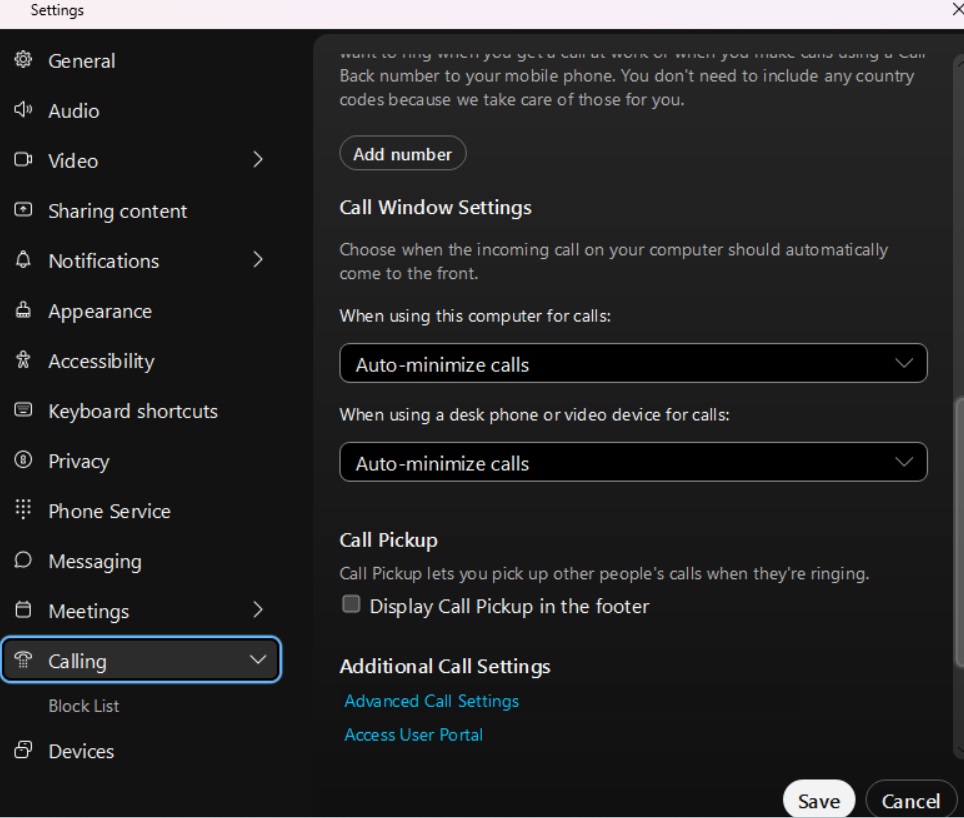
Wyłącz okno połączeń wielokrotnych dla użytkowników systemu Windows:
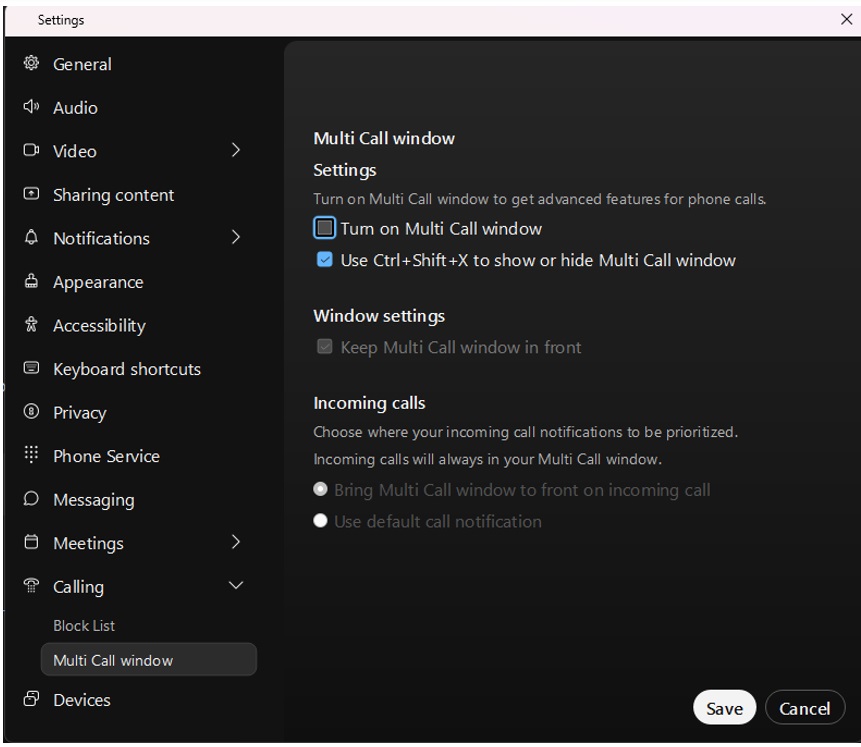
Konsola Webex Attendant zapewnia prosty i intuicyjny interfejs użytkownika, bez konieczności przeprowadzania skomplikowanych szkoleń. Aby zapoznać się wstępnie z zawartością konsoli Webex Attendant, zobacz reprezentację głównych paneli i ich funkcji.
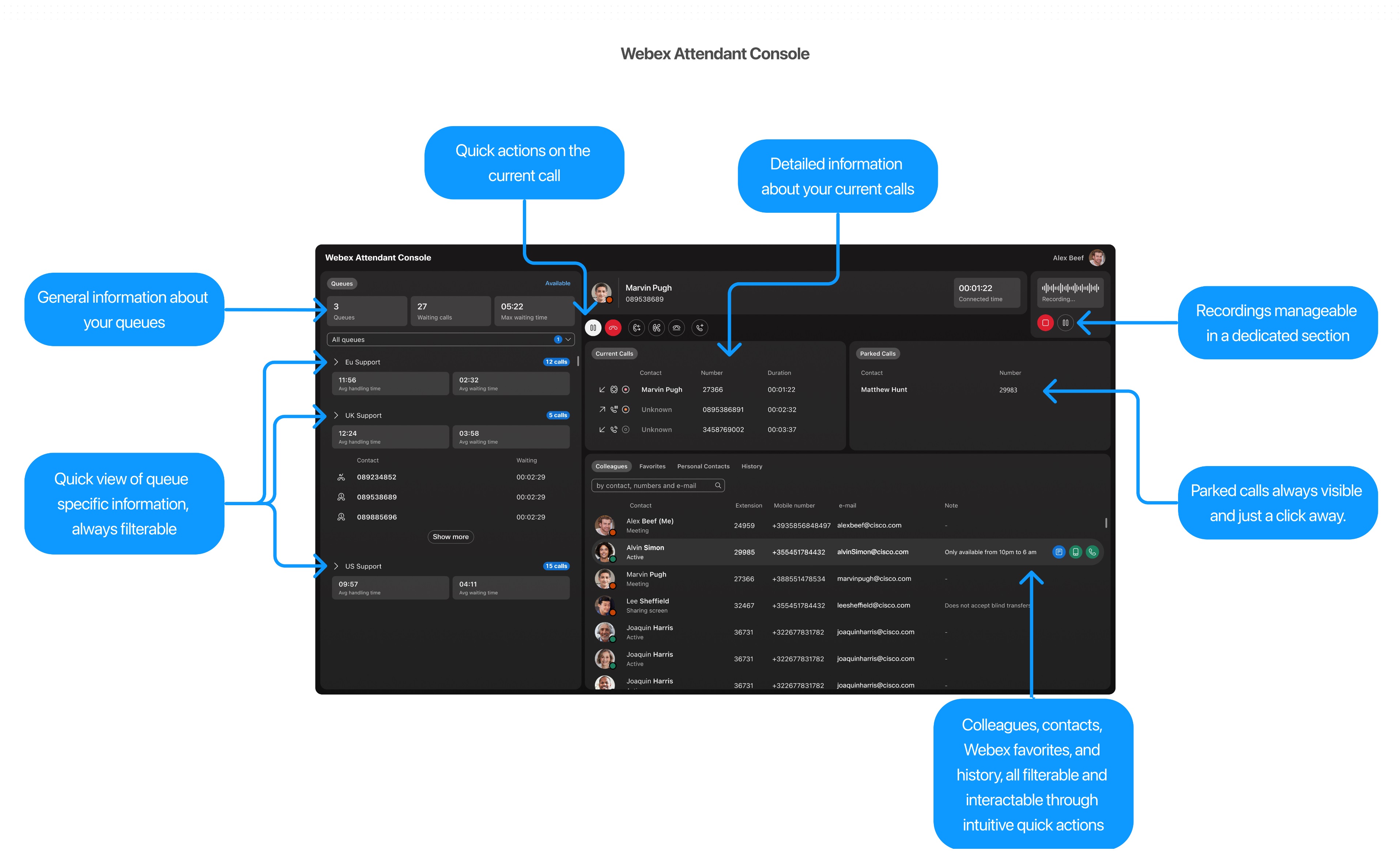
Uzyskaj dostęp do konsoli Webex Attendant
Aby uzyskać dostęp do konsoli Webex Attendant, potrzebna jest aplikacja Webex.
-
Otwórz aplikację Webex i kliknij WxAC Gadget.
Jeśli nie widzisz ikony WxAC Gadget, wyloguj się i uruchom ponownie aplikację Webex.
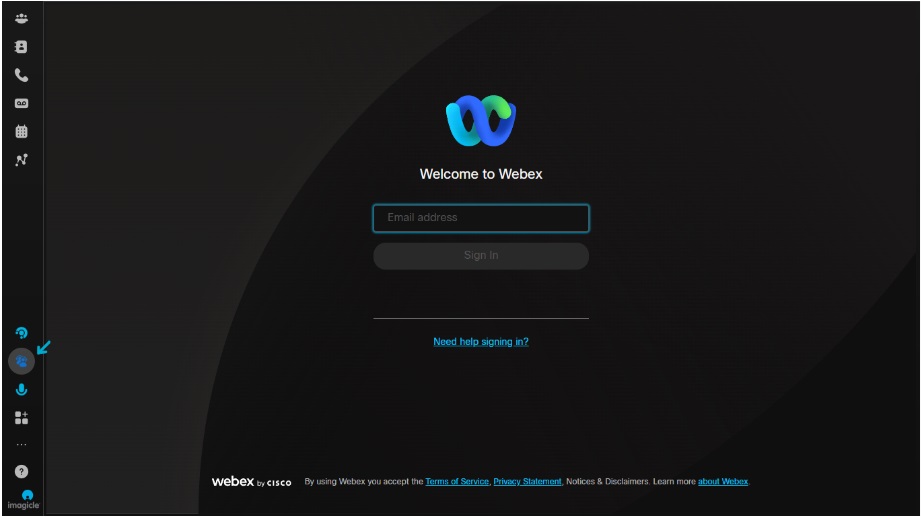
-
Wprowadź swoje dane.
Jeśli w Twojej organizacji włączono funkcję logowania jednokrotnego (SSO), wprowadź dane logowania, a zostaniesz przekierowany na stronę logowania dostawcy.
Zaakceptuj następujące uprawnienia konsoli Webex Attendant przy pierwszym logowaniu:
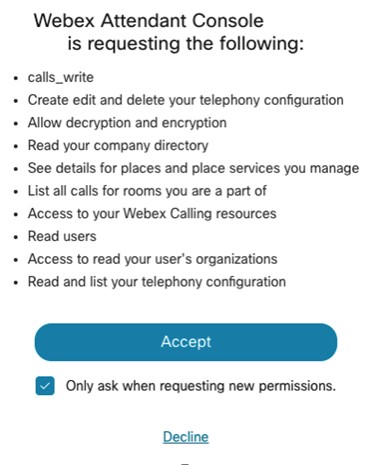
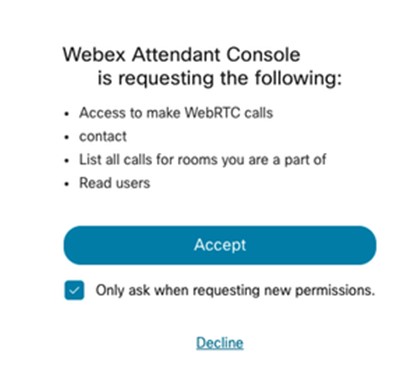
To zezwolenie umożliwia konsoli Webex Attendant kontrolowanie urządzenia wywołującego.
Włącz konsolę operatora
Można ręcznie przypisać użytkownika do konsoli operatora. Szczegóły znajdziesz w Dodawanie użytkowników ręcznie w Control Hub.
Możesz edytować licencję pojedynczego użytkownika w celu uzyskania dostępu do konsoli Attendant. Wybierz użytkownika posiadającego licencję Calling Professional, a następnie wybierz opcję Attendant Console. Szczegóły można znaleźć w sekcji Edytuj licencje usług w Control Hub dla poszczególnych użytkowników.
Aby uzyskać dostęp do konsoli operatora, użytkownik musi posiadać licencję Webex Calling Professional.
Z Centrum sterowaniaprzejdź do Użytkowniki wybierz użytkownika, aby włączyć konsolę operatora.
Kliknij Połączenie i przewiń do Doświadczenie użytkownika połączenia > Konsola operatora, aby włączyć konsolę operatora.
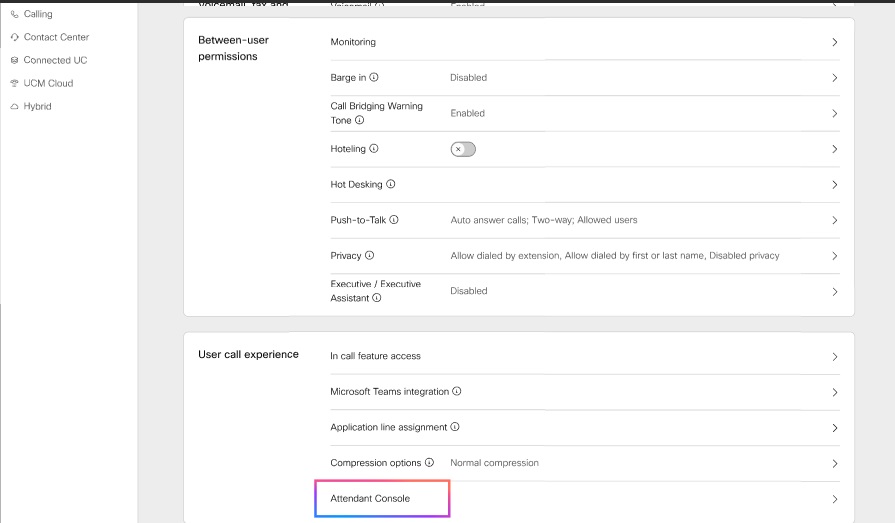
Po udzieleniu użytkownikowi licencji na Konsolę operatora administrator może korzystać z funkcji Konsoli operatora.
Aby utworzyć listę ulubionych dla użytkownika, przejdź do Centrum sterowania, przejdź do Usługi > Powołanie > Karta Funkcje.
Wyświetl konsolę operatora
Jako administrator użyj Konsoli operatora, aby wyświetlić listę skonfigurowanych użytkowników konsoli.
- Z Centrum sterowaniaprzejdź do Usługi > Powołanie > Cechy > Konsola operatora, wybierz Konsola operatora.
- Wybierz lokalizację i kliknij OK.
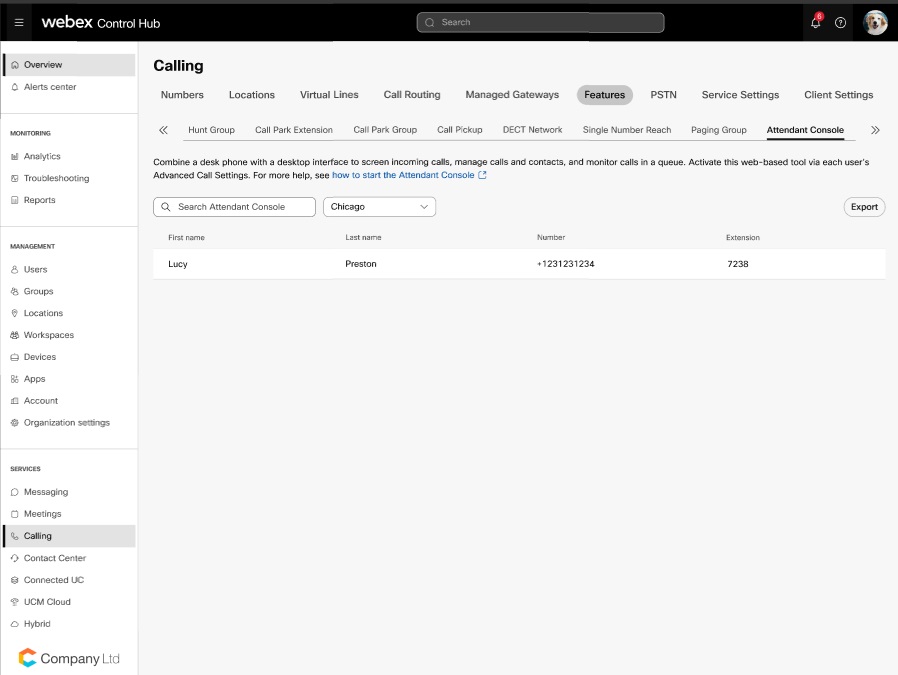
Domyślnie integracje z konsolą Webex Attendant są włączone. Jeśli jednak administrator klienta wyłączył App/Integrations, włączyć App/Integrations używając identyfikatora integracji. Z Centrum sterowaniaprzejdź do Zarządzanie>Aplikacje i wprowadź identyfikator integracji.
- Wyszukaj osoby lub obszary robocze, które chcesz, aby ten użytkownik monitorował, a następnie kliknij Zapisz.
- Widzisz imię i nazwisko osoby przypisanej do roli recepcjonisty oraz jej numer telefonu. Kliknij Eksportuj, jeśli chcesz wyeksportować tę listę.
Chcesz poznać i zrozumieć funkcje konsoli Webex Attendant? Obejrzyj Rozpoczęcie pracy z konsolą Webex Attendant
Doświadczenie dla obecnych użytkowników klienta Recepcjonisty z wersją próbną
Jeśli korzystasz z istniejącej funkcji klienta recepcjonisty i planujesz migrację do konsoli Webex Attendant, zwróć uwagę na następujące wskazówki:
-
Możesz nadal korzystać z funkcji Klienta Recepcjonisty wraz z subskrypcją próbną Konsoli Obsługującej. Opcję Konsoli operatora zobaczysz w aplikacji Webex. W trakcie wersji próbnej zakładka funkcji Konsoli Obsługującej nie jest widoczna, a do ulubionych używane są istniejące ustawienia Klienta Recepcjonisty.
-
Po zakupieniu licencji na konsolę Attendant Console nie będziesz już widzieć klienta recepcjonisty ani ustawień połączeń użytkownika w obszarze User Call Experience w Control Hub. Jednakże do momentu zakończenia wsparcia technicznego dostęp do Klienta Recepcjonisty będzie możliwy za pomocą łącza https://apps.broadcloudpbx.net/receptionist/login/cisco/?authorize=cisco. Nie ma utraty danych konfiguracyjnych, takich jak ulubione.
Organizacje, które nie korzystają z Konsoli Recepcjonisty, nie mogą włączyć Klienta Recepcjonisty z poziomu Centrum sterowania.
Zarządzanie kontaktami
Szybkie wyszukiwanie
Funkcja szybkiego wyszukiwania zapewnia uproszczony sposób lokalizowania kontaktów w konsoli, co zwiększa Twoją produktywność. Dostęp do okna Szybkiego wyszukiwania można uzyskać, wykonując dowolną z poniższych czynności w systemie:
-
Rozpocznij nowe połączenie: Nawiązywanie połączenia.
-
Rozpocznij transfer konsultacji: Rozpoczęcie transferu konsultacji.
-
Rozpocznij transfer w ciemno: Rozpoczęcie transferu w ciemno.
Aby uzyskać przegląd, obejrzyj 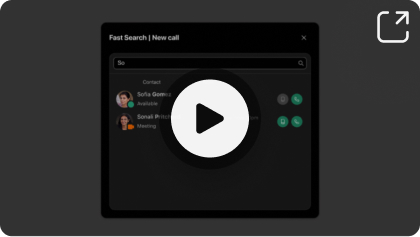
Otwórz okno dialogowe Szybkie wyszukiwanie, aby przeszukać różne katalogi. Aby rozpocząć wyszukiwanie, wykonaj następujące kroki:
| 1 |
Wpisz wyszukiwane hasło w wyznaczonym polu. Zapytania mogą obejmować imiona, numery telefonów i adresy e-mail. |
| 2 |
Naciśnij Enter lub kliknij ikonę lupy, aby wyszukać. Jeśli zapytanie nie przyniesie rezultatu w postaci żadnych pasujących kontaktów, zostanie wyświetlone powiadomienie. Jeśli wyszukiwanie zakończy się powodzeniem, powiązane wyniki zostaną wyświetlone pod polem wyszukiwania. Kontakty osobiste odpowiadające Twojemu zapytaniu mają pierwszeństwo przed kontaktami z innych katalogów. |
Każdy wynik wyszukiwania wyświetla się z następującymi szczegółami:
-
Awatar kontaktu wraz z jego aktualnym statusem obecności.
-
Powiązane notatki (jeśli dostępne)
-
Przyciski akcji, które różnią się w zależności od sposobu uruchomienia okna dialogowego Szybkie wyszukiwanie. Na przykład, jeśli uzyskałeś dostęp do okna modalnego za pomocą akcji Rozpocznij nowe połączenie, znajdziesz przyciski umożliwiające zainicjowanie połączenia dla każdego pasującego kontaktu.
Aby załadować dodatkowe wyniki, przewiń w dół za pomocą myszy.
Jeśli jesteś w trakcie rozmowy i próbujesz nawiązać inne połączenie za pomocą Panelu szybkiego wyszukiwania, bieżące połączenie zostanie wstrzymane.
Szukaj w katalogu współpracowników
Karta Współpracownicy ma usprawnić Twój dostęp do najważniejszych informacji o współpracownikach w organizacji. Można szybko i sprawnie pobrać dane kontaktowe, aktualizacje obecności, numer wewnętrzny, numer telefonu komórkowego i inne informacje, takie jak adres e-mail lub osobiste notatki kontaktowe.
Chcesz zobaczyć jak to się robi? Obejrzyj:
Aby poruszać się po katalogu, wpisz imię i nazwisko, numer telefonu lub adres e-mail w pasku wyszukiwania i kliknij Enter lub ikonę wyszukiwania.
Użyj zakładki Współpracownicy, aby przeszukać wszystkich użytkowników w Control Hub, a nie tylko użytkowników usługi Webex Calling. Możesz filtrować użytkowników według konkretnej lokalizacji lub grupy.
Najechanie kursorem na kontakt ujawnia określone działania, takie jak:
-
Dodaj do ulubionych
-
Dodawanie lub edytowanie notatki
-
Dzwonienie na numer telefonu komórkowego
-
Dzwonienie pod numer wewnętrzny
Można również znaleźć opis statusu obecności kontaktu. Jeśli skonfigurowano, opis obejmuje zarówno obecność zespołu Webex, jak i Microsoft.
Przeszukaj ulubiony katalog
Konsola Webex Attendant umożliwia zarządzanie dwoma typami kontaktów ulubionych:
-
Ulubione zarządzane samodzielnie – zarządzane przez każdą osobę recepcjonistki
-
Ulubione zarządzane przez administratora – zarządzane przez administratora dla konkretnego recepcjonisty
Chcesz zobaczyć jak to się robi? Obejrzyj:
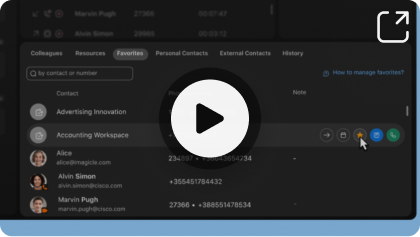
Ulubione zarządzane samodzielnie
Ulubione są elastyczne, ponieważ użytkownicy-recepcjoniści mogą dodawać i usuwać kontakty.
Aby dodać nowy kontakt do zakładki Ulubione, kliknij ikonę gwiazdki obok kontaktu z zakładki Współpracownicy lub Zasoby.
Możesz przeszukiwać swoje ulubione kontakty, sprawdzać informacje o ich obecności i dzwonić na powiązane z nimi numery.
Aby usunąć kontakt z Ulubionych, kliknij ikonę gwiazdki obok kontaktu na karcie Ulubione lub na karcie Współpracownicy i Zasoby.
Ulubione zarządzane przez administratora
Tylko administratorzy mogą dodawać, usuwać i zarządzać tymi ulubionymi, natomiast recepcjoniści mogą przeglądać kontakty wymienione na karcie Ulubione.
Tylko administratorzy mogą dodawać i zarządzać kontaktami na liście ulubionych za pomocą Centrum sterowania. W tym celu należy wykonać następujące czynności:
| 1 |
Zaloguj się do Centrum sterowania. Przejdź do Użytkownicy> Kierownictwo.
|
| 2 |
Wybierz użytkownika recepcjonisty, którego chcesz dodać do ulubionych. |
| 3 |
Kliknij Połączenia i przewiń do Doświadczenie użytkownika w zakresie połączeń, kliknij Konsola operatora. |
| 4 |
Wpisz nazwę i numer ulubionego kontaktu w polu wyszukiwania.
|
| 5 |
Możesz wybrać opcję Dodaj lub Usuń ulubione. |
| 6 |
Kliknij opcję Zapisz. |
Szukaj korzystając z kontaktów Zasoby
Użyj zakładki Zasób, aby przeszukać następujące zasoby usługi Webex Calling:
Chcesz zobaczyć jak to się robi? Obejrzyj:
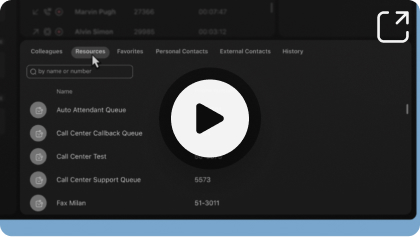
-
Kolejki połączeń
-
Grupy łowieckie
-
Automatyczni operatorzy
-
Obszary robocze
-
Rozszerzenia wirtualne
-
Linie wirtualne
Możesz dodać kontakty do ulubionych.
Zasoby telefoniczne i rozszerzonej obecności nie są dostępne.
Szukaj za pomocą kontaktów zewnętrznych
Użyj zakładki Kontakty zewnętrzne, aby przeszukiwać kontakty korporacyjne w Control Hub w formie scentralizowanej książki adresowej.
Chcesz zobaczyć jak to się robi? Obejrzyj:
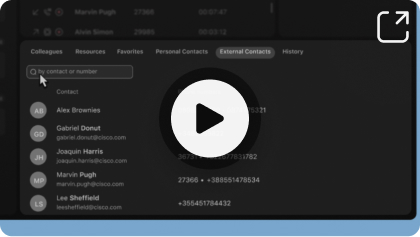
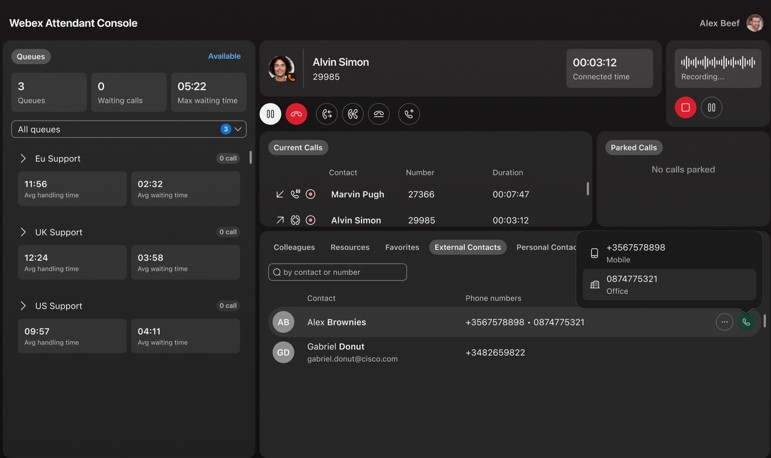
Źródłami kontaktów mogą być:
-
Lokalny (ręcznie załadowany do Control Hub)
-
BroadWorks
-
Protokół LDAP (Lightweight Directory Access Protocol)
-
Cisco Unified Communications Manager
Zarządzaj katalogiem osobistym
Możesz dodać kontakty, które nie są częścią Twojej organizacji, wykonując następujące kroki:
Chcesz zobaczyć jak to się robi? Obejrzyj:
-
Użyj zakładki Kontakty osobiste, a następnie kliknij Utwórz.
-
Wpisz imię i nazwisko oraz numer telefonu osoby, którą chcesz dodać, a następnie kliknij Potwierdź.
-
Możesz edytować i usuwać kontakty, a także nawiązywać z nimi połączenia. Najedź kursorem na wiersz tabeli kontaktów i kliknij przycisk odpowiadający wymaganej akcji.
Po dodaniu kontaktów osobistych te same kontakty pojawią się na liście kontaktów w aplikacji Webex i odwrotnie.
Aby uzyskać przegląd, obejrzyj Korzystanie z katalogu osobistego.
Dodaj notatkę
Użyj Konsoli operatora, aby dodawać notatki do współpracowników i ulubionych kontaktów. Najedź kursorem na wiersz kontaktu i wybierz kontakt, a następnie kliknij opcję Dodaj notatkę.
Notatki są prywatne i mają limit 255 znaków.
Karty konfigurowalne
Zarządzaj swoimi kontaktami, korzystając z konfigurowalnych kart
Funkcja Dostosowywalne karty wprowadza elastyczny i sterowany przez użytkownika sposób organizowania kontaktów w konsoli Webex Attendant. Umożliwia definiowanie, zmienianie nazw, porządkowanie i przypisywanie kontaktów do kart na podstawie osobistego przepływu pracy lub potrzeb organizacji.
Okienko zarządzania kartami jest dostępne w prawym rogu interfejsu panelu kontaktów. Kliknij nową ikonę, aby otworzyć menu, w którym możesz:
-
Pokaż lub ukryj istniejące karty używając pól wyboru.
-
Dodaj nowe niestandardowe karty według nazwy.
-
Zmień kolejność kart, przeciągając je i upuszczając w oknie podręcznym.
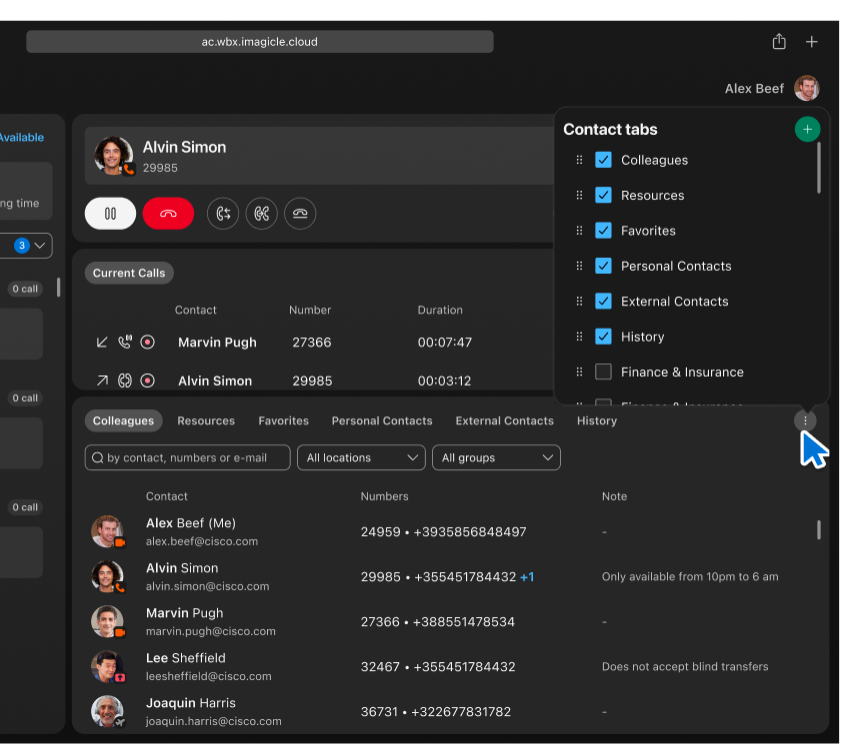
Interfejs ten zapewnia pełną kontrolę nad układem kontaktów, obsługując różne przypadki użycia, od podziału na działy po ustalanie priorytetów kontaktów.
Tworzenie i organizowanie niestandardowych kart
Możesz tworzyć nowe zakładki, takie jak Finanse & Ubezpieczenie, Usługa & Konserwacjai części & Inventory, które pojawiają się obok domyślnych (takich jak: Koledzy i Ulubione), dzięki czemu nawigacja jest bardziej przejrzysta i intuicyjna.
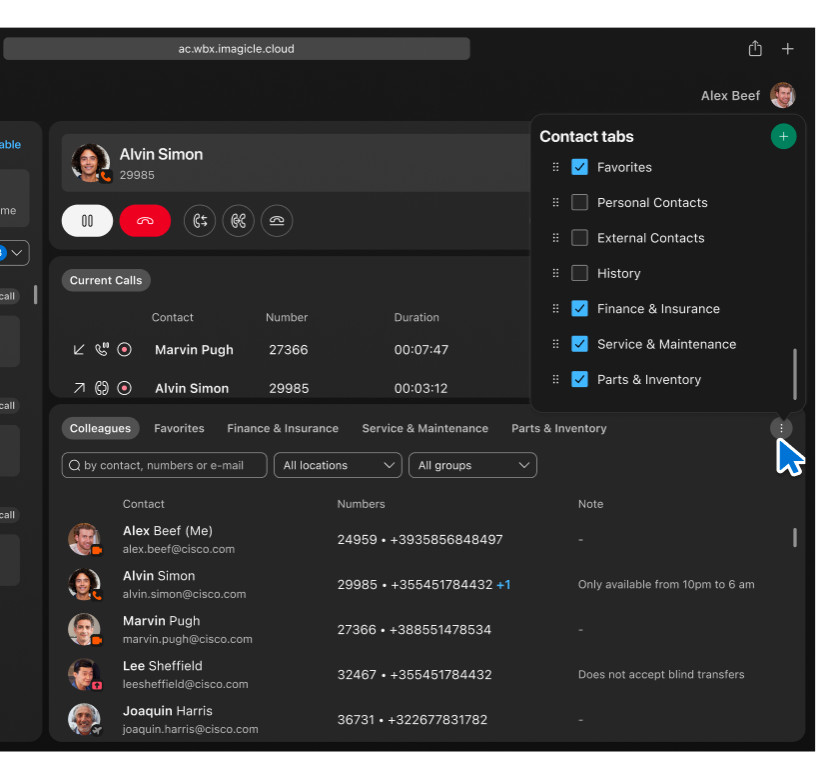
W każdej chwili możesz przełączać widoczność tych kart za pomocą tego samego menu.
Przypisywanie kontaktów do kart
Możesz przypisać kontakt do jednej lub kilku kart. Po kliknięciu ikony gwiazdki lub menu kontekstowego kontaktu pojawia się okno dialogowe umożliwiające przypisanie wielu kart za pomocą pól wyboru.
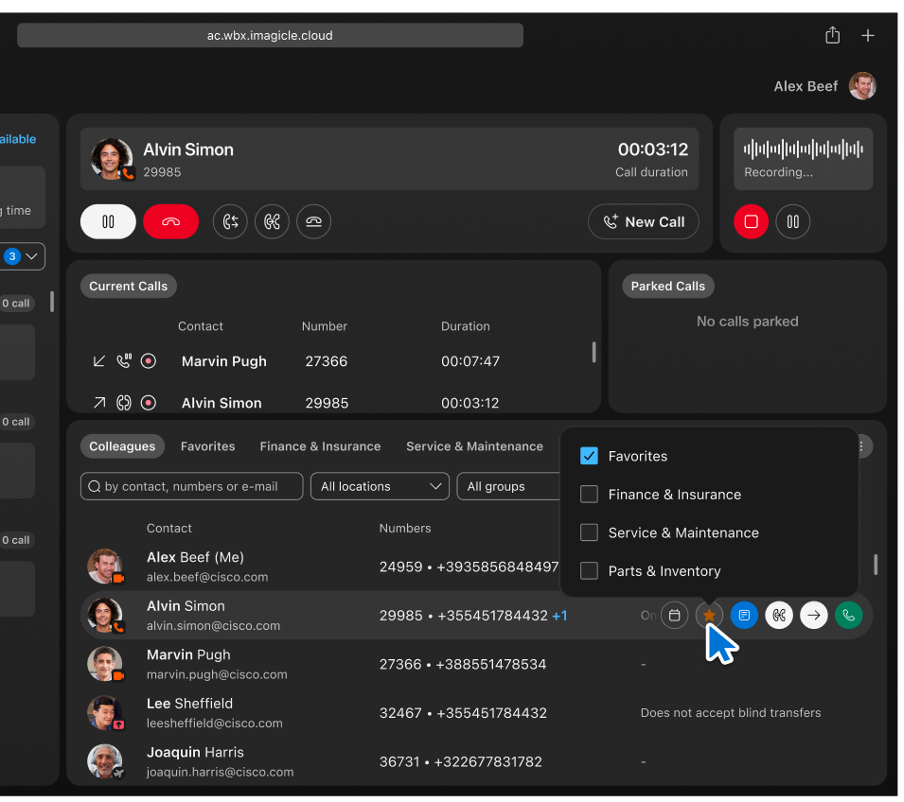
Korzyści:
-
Pełna personalizacja— Zdefiniuj dowolną liczbę kart dla dowolnego przepływu pracy.
-
Zarządzanie na bieżąco— dodawaj lub przypisuj kontakty podczas operacji na żywo.
-
Przejrzystość wizualna— Wszystkie karty są wyraźnie widoczne i można łatwo przełączać się między nimi.
-
Skalowalność— Idealne rozwiązanie dla użytkowników zarządzających wieloma działami, klientami lub regionami.
Zarządzanie połączeniami
Zadzwoń z klawiatury
Możesz zadzwonić korzystając z zakładki Współpracownicy, Ulubione, Kontakty osobiste lub Historia. Przewiń do kontaktu, a zostanie on podświetlony, co umożliwi wykonanie połączenia.
Aby wykonać połączenie z klawiatury.
| 1 |
Wprowadź prawidłowy numer i naciśnij Enter na klawiaturze lub kliknij przycisk Zadzwoń. |
| 2 |
Możesz też kliknąć ikonę słuchawki telefonicznej, aby wykonać szybkie wyszukiwanie i zadzwonić do zapamiętanego kontaktu. Aby wykonać połączenie bezpośrednio, bez odbierania i odbierania połączeń przychodzących, należy ustawić Preferowane urządzenie w preferencjach urządzenia. |
Zadzwoń z szybkiego wyszukiwania
Funkcjonalność Rozpocznij nowe połączenie umożliwia szybkie i efektywne inicjowanie połączeń za pomocą okna szybkiego wyszukiwania. Funkcja ta ułatwia dotarcie do Twoich kontaktów. Aby rozpocząć, wykonaj następujące kroki:
| 1 |
Kliknij przycisk Rozpocznij nowe połączenie. Panel Szybkie wyszukiwanie wyświetla usprawniający proces inicjowania połączeń. |
| 2 |
W panelu Szybkie wyszukiwanie wprowadź kryteria wyszukiwania, aby znaleźć żądany kontakt. Można wyszukiwać według nazwiska, numeru telefonu lub numeru wewnętrznego. |
| 3 |
Wybierz osobę, do której chcesz zadzwonić i wybierz jeden z dostępnych numerów kontaktowych, np. numer telefonu komórkowego, stacjonarnego lub wewnętrznego. |
| 4 |
Kliknij przycisk Zadzwoń powiązany z wybranym numerem telefonu, aby nawiązać połączenie. |
Zarządzaj połączeniami
Odbierz połączenie
Aby odebrać połączenie, kliknij przycisk Odbierz połączenie na klawiaturze lub skorzystaj z panelu Bieżące połączenia. Upewnij się również, że wybrałeś preferowane urządzenie w preferencjach urządzenia.
Wstrzymanie/Wznowienie
Użyj Przytrzymaj /Resume Funkcja umożliwiająca kontrolowanie aktywnych połączeń, dzięki której można wstrzymywać i wznawiać rozmowę.
-
Wstrzymaj połączenie— Aby wstrzymać aktywne połączenie, kliknij przycisk Wstrzymaj. Ta akcja wstrzymuje połączenie, a ikona statusu obok wpisu połączenia w panelu Bieżące połączenia zostaje zaktualizowana.
-
Wznów wstrzymane połączenie— Aby wznowić aktualnie wstrzymane połączenie na pierwszym planie, kliknij przycisk Wznów. Ta czynność wznawia zawieszone połączenie, umożliwiając kontynuowanie rozmowy.
Możesz wznowić połączenie z panelu Aktualne połączenia. Kliknij dwukrotnie połączenie lub kliknij przycisk Wznów, który pojawi się po najechaniu kursorem na połączenie.
Przekaż połączenie
Aby przekazać połączoną rozmowę, użyj jednej z poniższych metod w konsoli Webex Attendant:
-
Transfer w ciemno
-
Uczestniczyłem w transferze
-
Szybki transfer
Transfer w ciemno
Przekierowanie w ciemno, nazywane również przekierowaniem bez nadzoru lub przekierowaniem na zimno, przekierowuje połączenie do nowego miejsca docelowego bez wcześniejszej konsultacji z odbiorcą. Użyj tej metody, aby przekierować połączenie do innego agenta, innego działu lub kontaktu zewnętrznego.
Aby zainicjować przelew w ciemno, wykonaj następujące kroki:
-
Kliknij przycisk Rozpocznij transfer w ciemno znajdujący się pod klawiaturą.
-
Wyświetla się panel Szybkie wyszukiwanie. Użyj go, aby zlokalizować kontakt.
-
Wybierz, czy chcesz przekierować połączenie na numer wewnętrzny czy numer komórkowy kontaktu i wykonaj przekierowanie w ciemno.
Aby uzyskać ogólny zarys, obejrzyj Blind Transfer.
Uczestniczyłem w transferze
Przekierowanie z obsługą, zwane także przekierowaniem ciepłym lub konsultacyjnym, umożliwia skonsultowanie się z odbiorcą przed zakończeniem przekierowania rozmowy.
Aby zainicjować przelew z obsługą, wykonaj następujące kroki:
-
Kliknij przycisk Rozpocznij transfer konsultacji.
-
Wyszukaj osobę kontaktową, z którą chcesz się skonsultować, i kliknij wyznaczony przycisk, aby rozpocząć konsultację.
-
Po konsultacjach kliknij Zakończ transfer, aby zakończyć transfer.
Aby uzyskać przegląd, obejrzyj Przeniesienie z udziałem.
Szybki transfer
Konsola Webex Attendant umożliwia szybkie przekierowanie połączenia do wybranego miejsca docelowego. Wybierz odpowiednie miejsce docelowe w dowolnym panelu kontaktów: Współpracownicy, Ulubione, Kontakt osobisty lub Historia połączeń.
Funkcja ta umożliwia wygodne przekierowywanie połączeń do często używanych miejsc docelowych.
Aby zainicjować szybkie przekierowanie podczas aktywnej rozmowy, użyj opcji Przekierowanie w ciemnolub Rozpocznij przekierowanie w ramach konsultacji i przekieruj rozmowę na numer wewnętrzny lub numer komórkowy. Wybierz przycisk akcji przy odpowiednim kontakcie.
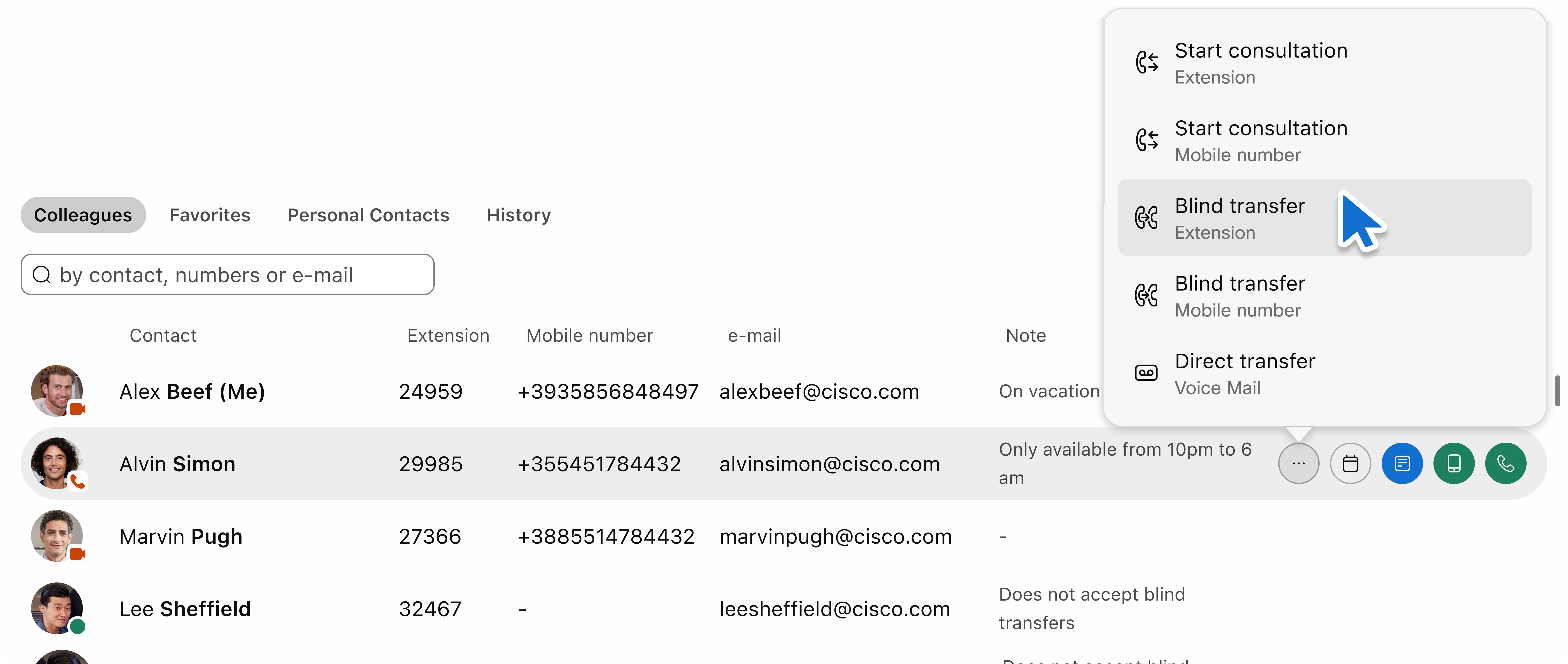
Przekieruj połączenie na pocztę głosową
Czasami konieczne jest przekierowanie połączenia na pocztę głosową odbiorcy, zwłaszcza gdy jest on niedostępny lub poza godzinami pracy.
-
Aby rozpocząć przekierowanie do poczty głosowej, przejdź do panelu Szybkie wyszukiwanie.
-
Kliknij przycisk Przekieruj do poczty głosowej, aby przekierować połączenie do poczty głosowej wybranego kontaktu.
Transfer jednym kliknięciem
Funkcja Przekierowanie jednym kliknięciem ułatwia przekierowywanie aktywnych połączeń przy minimalnej interakcji użytkownika. Przyciski kontekstowe umieszczone obok każdego kontaktu umożliwiają zainicjowanie przelewu za pomocą jednej czynności.
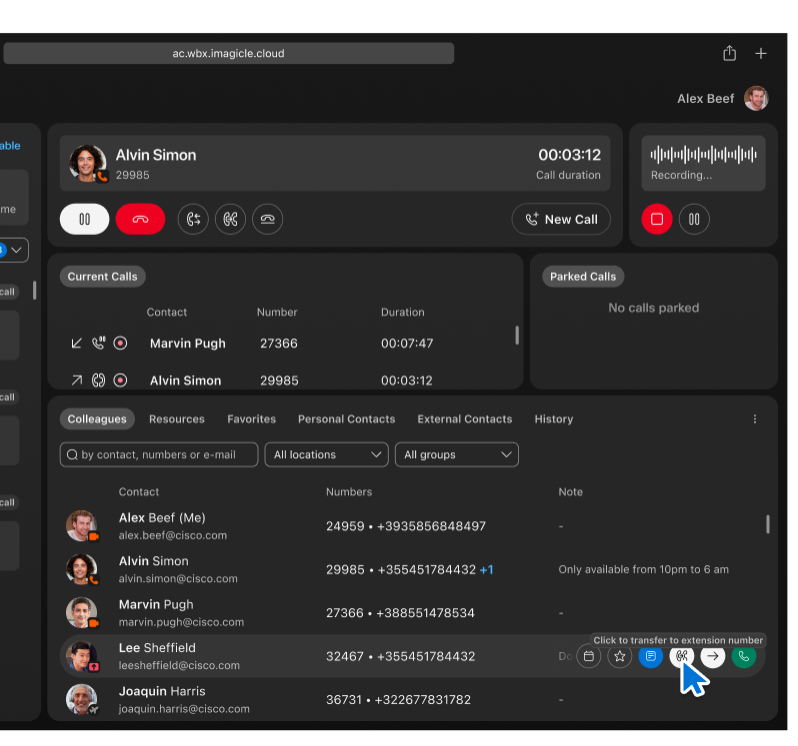
Gdy w konsoli Webex Attendant trwa aktywne połączenie, obok każdego kontaktu pojawiają się ikony akcji. Na poprzednim zrzucie ekranu możesz zobaczyć, jak ta funkcja wygląda w trakcie trwającej rozmowy, wyświetlając kontekstowe działania dla każdego kontaktu. Po najechaniu kursorem na ikonę przekierowania dla numeru Lee Sheffieldwyświetla się podpowiedź i możliwe jest natychmiastowe przekierowanie bieżącego połączenia na główny numer wewnętrzny Lee.
Podświetlony przycisk przekierowuje połączenie na wewnętrzny numer kontaktu za pomocą jednego kliknięcia. Nie musisz otwierać okien dialogowych ani ręcznie niczego wpisywać. Ikony są zależne od kontekstu i wyświetlają podpowiedzi po najechaniu kursorem, co ułatwia zrozumienie, np. Kliknij, aby przekierować na numer wewnętrzny.
Korzyści:
-
Prędkość— podejmij natychmiastowe działanie bez dodatkowych kroków interfejsu użytkownika.
-
Przejrzystość—Wizualne rozmieszczenie obok nazw kontaktów zapewnia łatwe odnajdywanie i korzystanie z nich.
-
Użyteczność— Zaprojektowano z myślą o miejscach o dużym natężeniu ruchu, takich jak recepcje czy centra obsługi połączeń.
Funkcja ta działa we wszystkich widocznych widokach kontaktów, w tym Ulubionych, Kartach i wynikach wyszukiwania, zapewniając spójną wydajność w całym interfejsie.
Wyświetl bieżące połączenia
Dostęp do panelu Aktualne połączenia można uzyskać w sekcji klawiatury, obok sekcji Zaparkowane połączenia. Wyświetla status trwających połączeń. Jeśli nie ma aktualnie żadnych połączeń, wyświetla się komunikat Brak połączeń w toku.
Każdy wpis dotyczący połączenia zawiera następujące informacje:
-
Kierunek: Wyświetla połączenia przychodzące lub wychodzące z odpowiednimi ikonami i tekstem alternatywnym.
-
Państwo: Wyświetla połączenia dzwoniące, wstrzymane lub nawiązane wraz z odpowiednimi ikonami i alternatywnym tekstem.
-
Kontakt Name/Surname: Wyświetla prawdziwe imiona i nazwiska współpracowników oraz kontaktów osobistych. W przypadku nierozpoznanych numerów zewnętrznych wyświetla się jako Nieznany użytkownik.
-
Numer telefonu
-
Czas trwania: Wyświetla czas trwania połączenia od zdarzenia inicjującego (w przypadku połączeń wybieranych) do zdarzenia odbierającego (w przypadku połączeń nawiązanych).
Jeśli nazwa kontaktu lub linia jest długa, zostaje skrócona i oznaczona wielokropkiem. Najechanie kursorem pokaże pełną nazwę.
W panelu Bieżące połączenia możesz zarządzać trwającymi połączeniami w następujący sposób:
-
Odbieranie połączenia: Możesz odebrać połączenie przychodzące, klikając ikonę odbierania.
-
Odrzucanie połączenia: Jeśli chcesz odrzucić połączenie przychodzące, kliknij ikonę rozłączenia.
-
Prowadzenie rozmowy: Aby tymczasowo wstrzymać trwające połączenie, kliknij ikonę wstrzymania.
-
Wznawianie połączenia: Jeśli wstrzymałeś połączenie, możesz je wznowić, klikając dwukrotnie połączenie lub klikając ikonę wznawiania.
-
Zakończenie połączenia: Aby zakończyć połączenie, kliknij ikonę rozłączenia.
-
Obsługa błędów: Jeśli występują jakiekolwiek błędy operacyjne, wyświetlane jest ogólne okno dialogowe błędów, które dostarcza dalszych wskazówek.
Oto niektóre funkcje panelu Bieżące połączenia:
-
Połączenia w panelu są automatycznie sortowane na podstawie godziny rozpoczęcia. Dzięki temu najnowsze połączenia będą wyświetlane na górze.
-
Jeżeli w panelu znajdują się więcej niż trzy połączenia, pojawia się pasek przewijania umożliwiający poruszanie się po liście.
-
Dostęp do historii połączeń
Panel Historia połączeń zawiera listę połączeń przychodzących, wychodzących i nieodebranych. Maksymalnie można wyświetlić 60 rekordów, przy czym dla każdego typu połączenia może przypadać maksymalnie 20 rekordów.
Lista składa się z czterech kolumn: Kierunek, nazwa kontaktu, numer, data i godzina. Początkowo lista jest sortowana rosnąco według daty, ale możesz posortować ją na podstawie każdej kolumny.
Aby nawiązać połączenie, najedź kursorem na każdy wiersz, aby uzyskać dostęp do ikony Wykonaj połączenie. Po zakończeniu połączenia lub wystąpieniu nowego zdarzenia związanego z połączeniem historia połączeń zostanie automatycznie zaktualizowana.
Ustaw preferowane urządzenie do wykonywania połączeń
Wybierz preferowane urządzenie do obsługi połączeń w konsoli Webex Attendant — może to być telefon służbowy lub aplikacja Webex.
Aby uzyskać dostęp do ustawień Preferowanego urządzenia, wykonaj następujące kroki:
| 1 |
Uzyskaj dostęp do swojego profilu: Zaloguj się do konsoli Attendant, znajdź ikonę swojego profilu lub awatara w sekcji nagłówka aplikacji.
Jeśli jeszcze nie ustawiłeś swojego preferowanego urządzenia i posiadasz więcej niż jedno urządzenie, na ikonie awatara zobaczysz ostrzeżenie. |
| 2 |
Wybierz preferowane urządzenie: Z wyświetlonego okna awatara wybierz opcję Preferowane urządzenie. Ta czynność spowoduje otwarcie akordeonu, w którym zobaczysz listę dostępnych urządzeń.
|
Rozpoczęcie połączenia konferencyjnego
Funkcja połączenia konferencyjnego umożliwia łączenie połączeń, umożliwiając dwóm lub więcej uczestnikom udział w jednej rozmowie.
Aby rozpocząć połączenie konferencyjne, wykonaj następujące czynności:
| 1 |
Rozpocznij pierwsze połączenie- Zadzwoń do jednego z uczestników. |
| 2 |
Rozpocznij drugie połączenie- Zadzwoń do drugiego uczestnika, a połączenie z pierwszym uczestnikiem zostanie automatycznie przełączone na oczekiwanie. 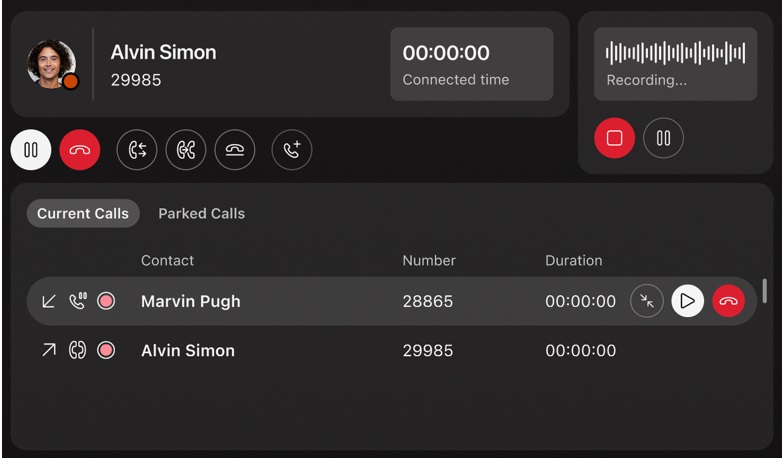 |
| 3 |
Scalanie połączeń w konferencję |
| 4 |
Zarządzanie konferencją i uczestnikami
|
Zaparkuj połączenie
Funkcja parkowania połączeń stanowi alternatywę dla oczekiwania na połączenie, a jej zaletą jest rozszerzenie możliwości zarządzania połączeniami:
-
Parking wielopoziomowy: W przeciwieństwie do tradycyjnego wstrzymywania połączeń, możesz zaparkować wiele połączeń jednocześnie, dzięki czemu zarządzanie wieloma rozmowami staje się łatwiejsze.
-
Wspólna widoczność: Po zaparkowaniu połączenia staje się ono widoczne i dostępne dla każdej osoby należącej do tej samej grupy parkingowej. Dzięki temu współpraca przebiega bez zakłóceń, a żadne połączenie nie pozostanie bez odpowiedzi.
Konfigurowanie parkowania połączeń
Włącz funkcję parkowania połączeń dla użytkownika bezpośrednio (dla osoby) lub jako grupę, aby przypisać użytkownika w konsoli operatora. Użyj funkcji Group Park, aby udostępnić wgląd recepcjoniście i użytkownikom oraz zarządzać parkowaniem połączeń.
Skonfiguruj Parkowanie grupowe dla lokalizacji użytkowników recepcji, a celem parkowania będą członkowie. Ustaw flagę Użyj członków jako miejsca docelowego parku. Dodaj wszystkich recepcjonistów danej lokalizacji jako członków. Do funkcji Parkowanie grupowe możesz dodać więcej użytkowników, aby umożliwić wykonywanie większej liczby jednoczesnych zaparkowanych połączeń.
Upewnij się, że każdy użytkownik w parku grupowym ma numer wewnętrzny.
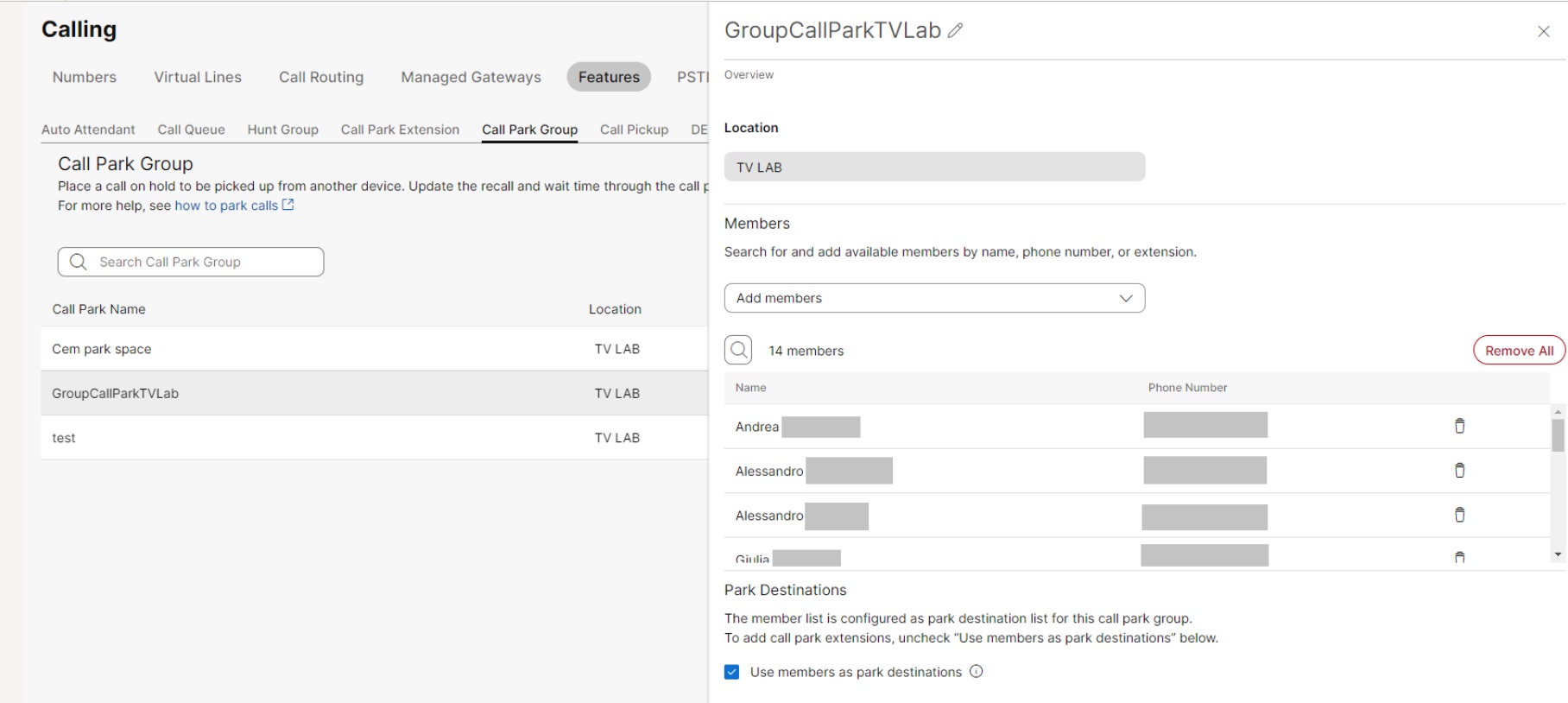
Aby zaparkować aktywne połączenie znajdujące się obecnie na pierwszym planie, kliknij przycisk Zaparkuj połączenie. Ta czynność natychmiast parkuje połączenie w wyznaczonej grupie parkingowej.
Po zaparkowaniu połączenie staje się widoczne w panelu Zaparkowane połączenia i jest dostępne dla wszystkich członków grupy parkowania. Następnie każdy upoważniony użytkownik może odebrać połączenie parkowane, co zapewnia sprawną obsługę połączeń i współpracę w zespole.
Uzyskaj dostęp do panelu kolejki
Jeśli Twoje konto ma uprawnienia do przeglądania kolejek, po lewej stronie interfejsu aplikacji znajdziesz odpowiedni panel. W tym panelu możesz zobaczyć kolejki, do których jesteś zapisany, a także obejrzeć statystyki.
Na górze panelu znajdują się trzy pola informacyjne, które umożliwiają zapoznanie się ze statystykami związanymi z kolejką. Statystyki te obejmują:
-
Kolejki subskrybowane: W tym polu wyświetlana jest całkowita liczba kolejek, do których jesteś zapisany.
-
Aktualne połączenia oczekujące: W tym polu wyświetlana jest bieżąca liczba połączeń oczekujących w kolejce.
Użytkownik musi włączyć opcję Połączenia oczekujące, aby połączenia pojawiały się w sekcji Bieżące połączenia w konsoli operatora.
-
Maksymalny czas oczekiwania: Metryka ta przedstawia najdłuższy czas oczekiwania na połączenie w kolejce.
Filtruj kolejki
Aby usprawnić widok i skupić się na kolejkach, które Cię interesują, użyj menu rozwijanego Wszystkie kolejki. Opcja ta umożliwia filtrowanie i wyświetlanie tylko kolejek odpowiadających Twoim bieżącym potrzebom, a ukrywanie tych mniej istotnych.
Obecnie nie można zmienić statusu agenta ani wypisać się z kolejki bezpośrednio w konsoli Attendant. Aby nie odbierać już połączeń z konkretnych kolejek, musisz anulować subskrypcję aplikacji Webex.
Statystyki specyficzne dla kolejki
Każda kolejka wyposażona jest w dedykowane statystyki, które obejmują:
-
Średni czas obsługi: Wskaźnik ten określa typowy czas potrzebny agentowi na obsługę połączenia od momentu dotarcia połączenia do kolejki.
-
Średni czas oczekiwania: Średni czas oczekiwania oznacza typowy czas, jaki dzwoniący spędza w kolejce, zanim dostępny agent odbierze jego połączenie.
Wyświetl zawartość kolejki
Aby wyświetlić aktualne połączenia w określonej kolejce, możesz rozwinąć panel, klikając na niego. Aby przywrócić pierwotny stan, wystarczy kliknąć na niego ponownie.
Chcesz zobaczyć jak to się robi, obejrzyj Uzyskaj dostęp do panelu Kolejka i wyświetl Statystyki.
Korzystanie z widoku kompaktowego
Kompaktowy widok zmniejsza puste przestrzenie, wysokość wiersza tabeli, rozmiar ikon i rozmiar czcionki. Dzięki temu w oknie aplikacji można wyświetlić więcej informacji.
Naciśnij ikonę Awatar osobisty w prawym górnym rogu aplikacji, aby włączyć lub wyłączyć opcję Widok kompaktowy.
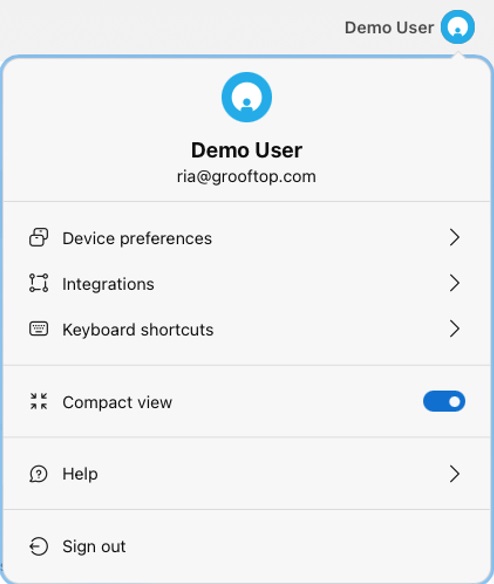
Nagrywanie połączeń
Opcja nagrywania rozmów umożliwia użytkownikom zapisywanie nagrań dźwiękowych swoich rozmów. Funkcja ta przydaje się do dokumentowania rozmów, archiwizowania ważnych informacji i zapewnienia wiarygodnego zapisu komunikacji do wykorzystania w przyszłości. Stanowi cenne narzędzie do prowadzenia dokładnych zapisów i przydaje się w kontekście zawodowym lub prawnym, gdzie dokumentacja ma zasadnicze znaczenie.
Ponadto niektóre przyciski w sekcji Nagrywanie rozmów są wyłączone ze względu na ustawienia konfiguracji użytkownika w Control Hub. Dzięki temu mamy pewność, że funkcjonalność będzie zgodna z uprawnieniami i ustawieniami konkretnego użytkownika. Administrator konfiguruje uprawnienia użytkownika do nagrywania rozmów.
Użytkownik bez włączonej usługi nagrywania
W przypadku użytkowników, którzy nie mają włączonej usługi nagrywania, panel nagrywania nie jest wyświetlany.
Użytkownik z włączoną usługą nagrywania
Jeśli nie ma żadnych trwających połączeń, wszystkie przyciski panelu nagrywania są nieaktywne, a animacja trwającego nagrywania nie jest widoczna.
W przypadku użytkowników z włączoną usługą nagrywania obowiązują następujące scenariusze, zależne od konfiguracji nagrywania:
-
Tryb nagrywania: Zawsze włączone— Użytkownicy z trybem nagrywania : Konfiguracja Always On umożliwia automatyczne rozpoczęcie nagrywania podczas połączeń przychodzących i wychodzących. Przycisk Stop jest widoczny, ale wyłączony.
-
Tryb nagrywania: Zawsze włączony Pause/Resume— Dla użytkowników z trybem nagrywania : Zawsze włączony Pause/Resume konfiguracji, zarówno połączenia przychodzące, jak i wychodzące wyzwalają automatyczną inicjację nagrywania. Przycisk Stop jest widoczny, ale pozostaje wyłączony.
Jeśli użytkownik zdecyduje się wstrzymać nagrywanie w trakcie jego trwania, zostanie ono tymczasowo wstrzymane, a przycisk Wznów stanie się widoczny.
Jeżeli celowo wstrzymasz nagrywanie, jego wznowienie spowoduje ponowne rozpoczęcie nagrywania
-
Tryb nagrywania: Na żądanie— Dla użytkowników z trybem nagrywania: W konfiguracji On Demand połączenia przychodzące i wychodzące nie powodują automatycznego rozpoczęcia nagrywania. Naciśnij przycisk Nagrywaj, aby rozpocząć proces nagrywania i Stop/Pause Przyciski są widoczne i funkcjonalne.
-
Gdy użytkownik wznawia wstrzymaną rozmowę, panel nagrywania wyświetla status nagrywania wznowionej rozmowy.
-
Podczas nagrywania rozmowy na panelu Aktywne rozmowy wyświetlana jest ikona nagrywania.
-
Gdy wystąpi błąd, wyświetla się okno dialogowe z komunikatem o błędzie.
Korzystanie ze skrótów klawiaturowych
Konsola WebexAttendant umożliwia wykonywanie czynności przy użyciu skrótów klawiaturowych. Funkcja ta umożliwia wygodne wykonywanie zadań za pomocą jednego naciśnięcia klawisza.
Odbieranie połączenia
Aby odebrać połączenie przychodzące, naciśnij Alt + A.
Dostęp do dostępnych skrótów klawiaturowych
Aby uzyskać dostęp do listy dostępnych skrótów klawiaturowych, wykonaj następujące kroki:
-
Kliknij na swój Awatar profilu w prawym górnym rogu interfejsu aplikacji. Ta akcja otwiera menu użytkownika.
-
W menu użytkownika znajdź i kliknij Skróty klawiaturowe, aby wyświetlić listę dostępnych skrótów.
Znajomość tych skrótów klawiaturowych pozwala na wydajniejszą nawigację i wykonywanie czynności, co przekłada się na lepsze ogólne wrażenia użytkownika.
Integracja z aplikacjami Microsoft
Konsola Attendant umożliwia integrację z platformami Microsoft, dzięki czemu masz dostęp do wszystkich niezbędnych informacji do obsługi połączeń. Możesz aktywować te dwie integracje:
-
Integracja z usługą MS Teams Presence
-
Integracja z Office 365
Aby uzyskać dostęp do ustawień integracji, wykonaj następujące kroki:
| 1 |
Uzyskaj dostęp do swojego profilu: Zaloguj się do konsoli Attendant, znajdź ikonę swojego profilu lub awatara w sekcji nagłówka aplikacji. Jeśli wcześniej zalogowałeś się do integracji Microsoft i Twoje dane logowania wygasły, na ikonie awatara zobaczysz ostrzeżenie. |
| 2 |
Kliknij swój awatar, aby wyświetlić menu podręczne i wybierz opcję Integracje. Ta akcja rozwija menu akordeonowe, w którym możesz wykonać jedną z następujących czynności:
Aby uzyskać przegląd, obejrzyj Integracja z usługą Microsoft Teams Presence i kalendarzem Office 365. |
Włączanie aplikacji MS Teams Presence i Office 365
Wykonaj poniższe kroki, aby zarządzać integracją z systemem Microsoft w ramach Konsoli Attendant.
Włączanie funkcji obecności
Funkcję Obecność można włączyć w menu głównym w ustawieniu Integracje.
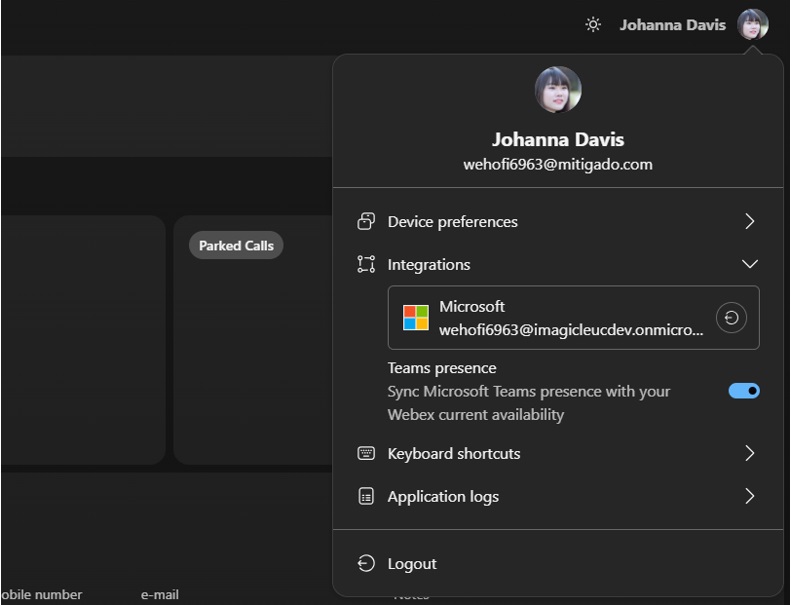
Po włączeniu funkcji Microsoft Presence konsola Attendant oblicza status dostępności na podstawie informacji pobranych przez Webex i Microsoft Teams. Konsola opiekuna wyświetla status na odznace awatara obecności. Gdy aplikacja Microsoft Teams pobierze status obecności, w dymku odznaki wyświetli się ta informacja.
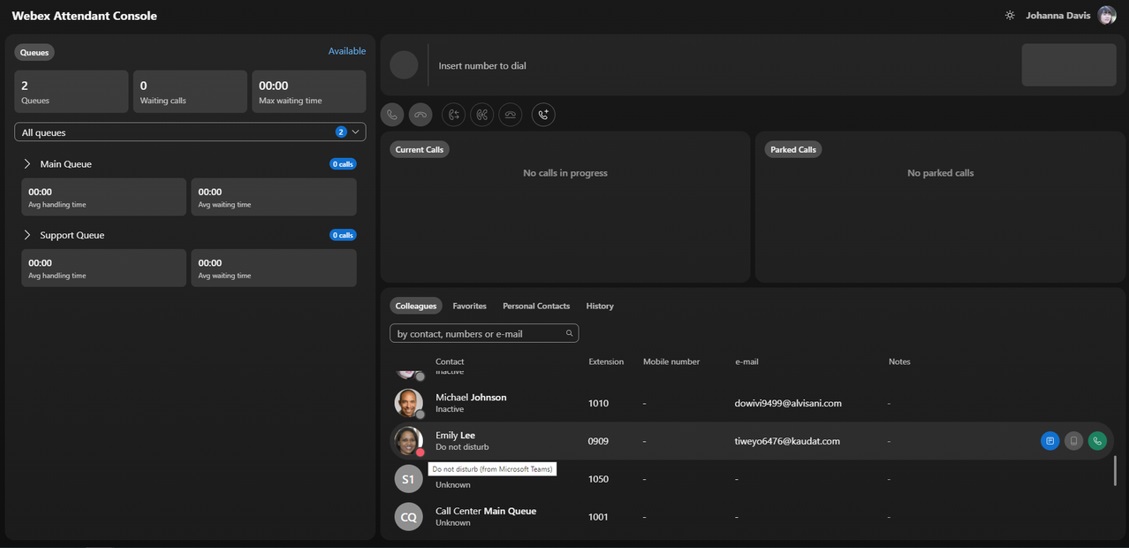
Włączanie funkcji Kalendarza
Przed rozpoczęciem
Jako administrator platformy Azure w organizacji upewnij się, że wyrażasz zgodę na dostęp do aplikacji korporacyjnej Imagicle Webex Attendant Console Connector . Zgodę możesz wyrazić w portalu Microsoft Azure. Aby udzielić uprawnienia, wykonaj poniższe kroki:
-
Uruchom aplikację Microsoft Azure i użyj pola wyszukiwania, aby znaleźć Webex Attendant Console.
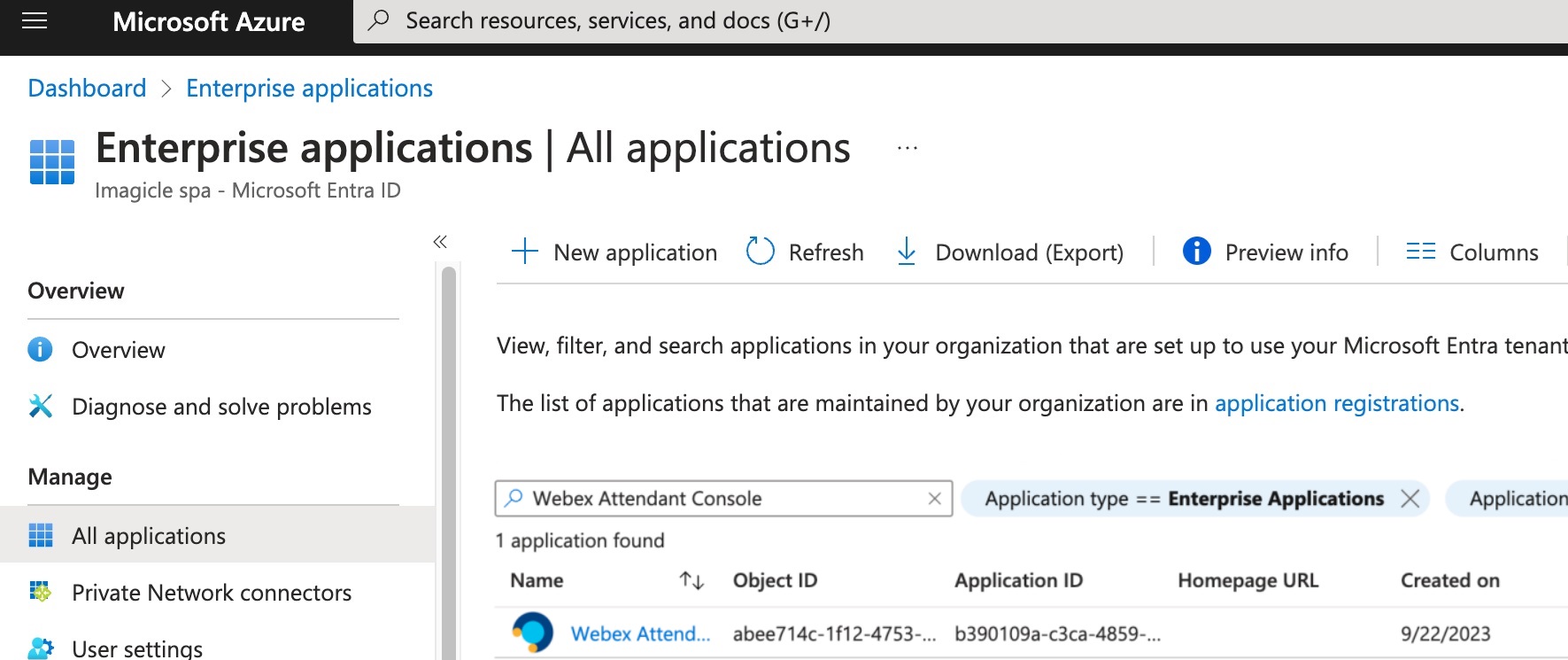
-
Przejdź do . Kliknij przycisk Udziel zgody administratora na ....
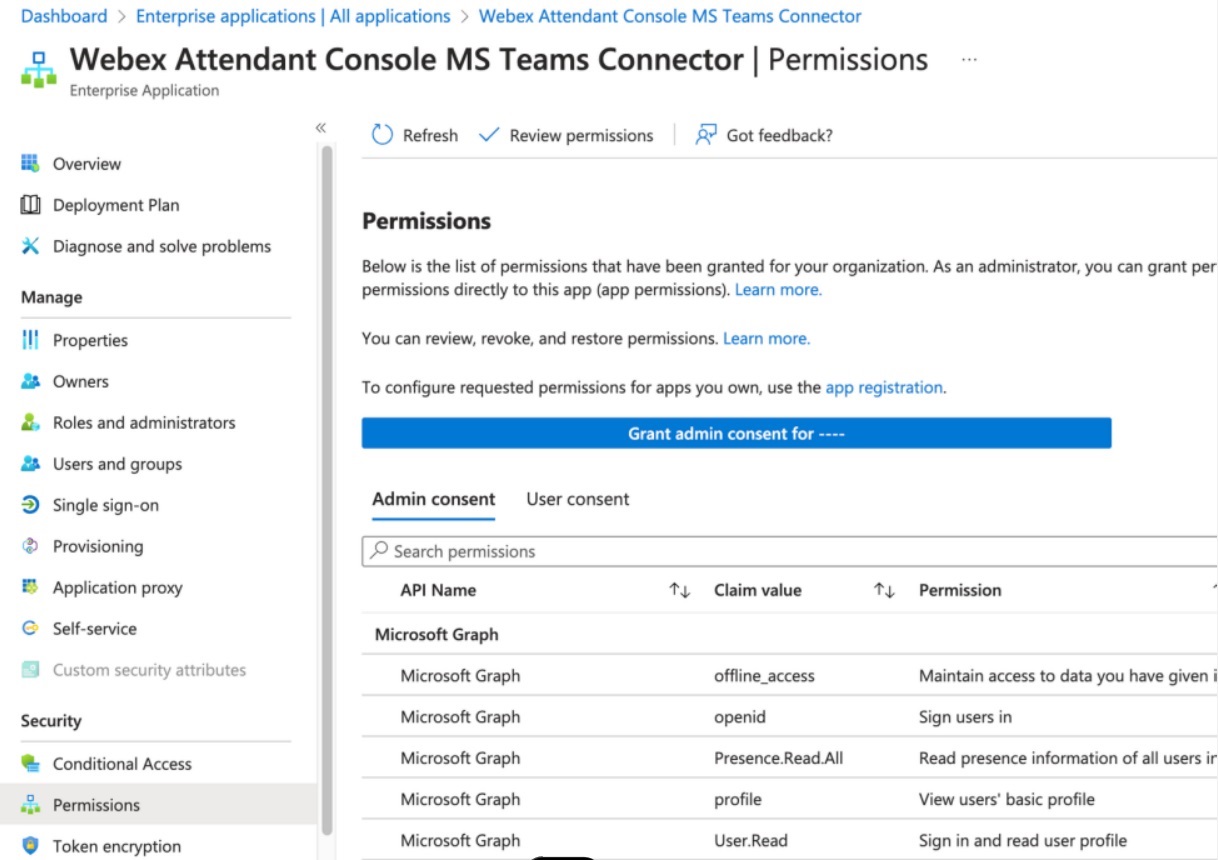
-
Wyświetla się okno Żądanie uprawnień. Przeczytaj prośbę i kliknij Akceptuję, aby wyrazić zgodę.

Funkcję Kalendarza można włączyć w menu głównym, w ustawieniu Integracje.
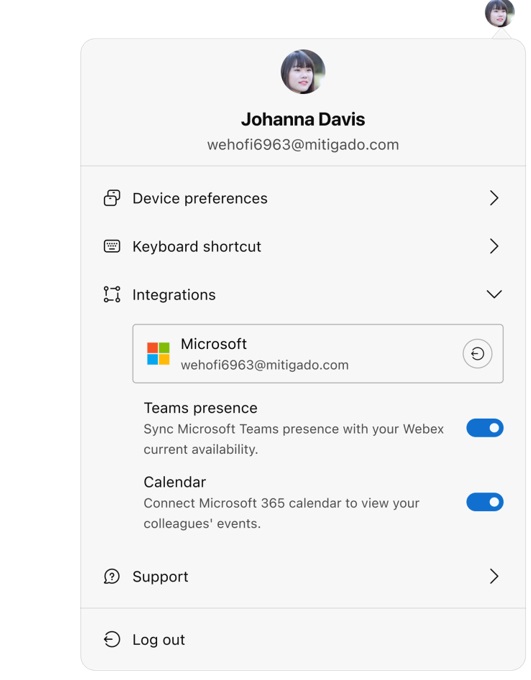
Po włączeniu funkcji Kalendarza Microsoft, przycisk Kalendarz jest wyświetlany, gdy użytkownik najedzie kursorem na wiersz współpracownika lub ulubionej tabeli. Po kliknięciu przycisku Kalendarz pojawia się okno dialogowe wyświetlające nadchodzące wydarzenia dla wybranego współpracownika (lub ulubionego).
